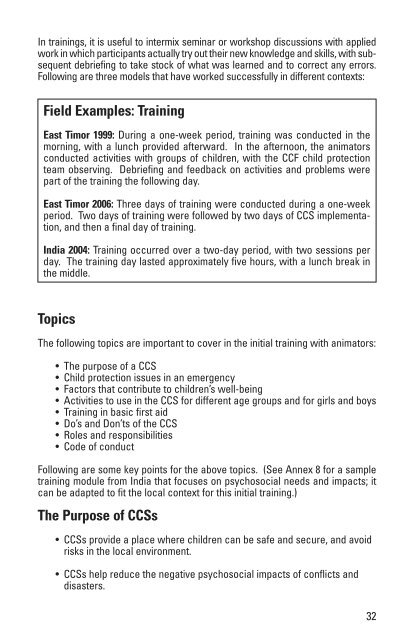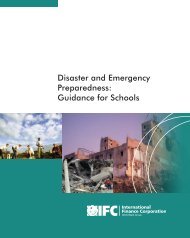Starting Up Child Centered Spaces in Emergencies: A Field Manual
Starting Up Child Centered Spaces in Emergencies: A Field Manual
Starting Up Child Centered Spaces in Emergencies: A Field Manual
- No tags were found...
Create successful ePaper yourself
Turn your PDF publications into a flip-book with our unique Google optimized e-Paper software.
In tra<strong>in</strong><strong>in</strong>gs, it is useful to <strong>in</strong>termix sem<strong>in</strong>ar or workshop discussions with appliedwork <strong>in</strong> which participants actually try out their new knowledge and skills, with subsequentdebrief<strong>in</strong>g to take stock of what was learned and to correct any errors.Follow<strong>in</strong>g are three models that have worked successfully <strong>in</strong> different contexts:<strong>Field</strong> Examples: Tra<strong>in</strong><strong>in</strong>gEast Timor 1999: Dur<strong>in</strong>g a one-week period, tra<strong>in</strong><strong>in</strong>g was conducted <strong>in</strong> themorn<strong>in</strong>g, with a lunch provided afterward. In the afternoon, the animatorsconducted activities with groups of children, with the CCF child protectionteam observ<strong>in</strong>g. Debrief<strong>in</strong>g and feedback on activities and problems werepart of the tra<strong>in</strong><strong>in</strong>g the follow<strong>in</strong>g day.East Timor 2006: Three days of tra<strong>in</strong><strong>in</strong>g were conducted dur<strong>in</strong>g a one-weekperiod. Two days of tra<strong>in</strong><strong>in</strong>g were followed by two days of CCS implementation,and then a f<strong>in</strong>al day of tra<strong>in</strong><strong>in</strong>g.India 2004: Tra<strong>in</strong><strong>in</strong>g occurred over a two-day period, with two sessions perday. The tra<strong>in</strong><strong>in</strong>g day lasted approximately five hours, with a lunch break <strong>in</strong>the middle.TopicsThe follow<strong>in</strong>g topics are important to cover <strong>in</strong> the <strong>in</strong>itial tra<strong>in</strong><strong>in</strong>g with animators:• The purpose of a CCS• <strong>Child</strong> protection issues <strong>in</strong> an emergency• Factors that contribute to children’s well-be<strong>in</strong>g• Activities to use <strong>in</strong> the CCS for different age groups and for girls and boys• Tra<strong>in</strong><strong>in</strong>g <strong>in</strong> basic first aid• Do’s and Don’ts of the CCS• Roles and responsibilities• Code of conductFollow<strong>in</strong>g are some key po<strong>in</strong>ts for the above topics. (See Annex 8 for a sampletra<strong>in</strong><strong>in</strong>g module from India that focuses on psychosocial needs and impacts; itcan be adapted to fit the local context for this <strong>in</strong>itial tra<strong>in</strong><strong>in</strong>g.)The Purpose of CCSs• CCSs provide a place where children can be safe and secure, and avoidrisks <strong>in</strong> the local environment.• CCSs help reduce the negative psychosocial impacts of conflicts anddisasters.32
















